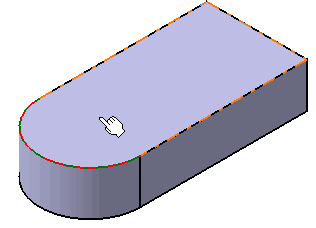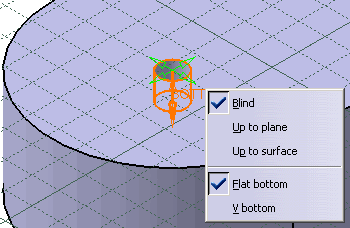 |
 |
 |
| Simple | Tapered | Counterbored |
-
Click the Hole icon
 to create a hole in Functional Molded Part.
to create a hole in Functional Molded Part. -
Select the circular edge and upper face as shown.
The application can now define one distance constraint to position the hole to be created. The hole will be concentric to the circular edge. The Hole Definition dialog box appears and the application previews the hole to be created. The Sketcher grid is displayed to help you create the hole.
Extensions
For the Hole Bottom
Whatever hole you choose, you need to specify the bottom limit you want. There is a variety of limits:
 |
 |
 |
| Blind | Up to Plane | Up to Surface |
 |
- Contextual creation commands are available on the BOTTOM
text:
- Blind
- Up to Plane
- Up to Surface
- Flat bottom
- V bottom
- The Limit field is available if you set the Up to Plane or Up to Surface option.


Preview
Result
For the Hole Top
The hole top is trimmed in two ways depending on whether the hole is created in a positive body or not.
- If you create a hole in a negative body, that is a body containing no material or a body with a negative feature as its first feature, the application always trims the top of the hole using the Up to Plane option and the plane used is the sketch plane.
-
Now, define the hole you wish to create. Enter 24mm as the diameter value and 25mm as the depth value.
Tolerancing Dimensions
You can define a tolerancing dimension for the hole
diameter just by clicking the icon ![]() to the right of the Diameter field. This capability displays the
Limit of Size Definition dialog box that enables you to choose
one method among three for defining your tolerance:
to the right of the Diameter field. This capability displays the
Limit of Size Definition dialog box that enables you to choose
one method among three for defining your tolerance:
-
Checking the Numerical values option: uses the values you enter to define the Upper Limit and optionally, the value of the Lower Limit field if you unchecked the Symmetric Lower Limit option.
-
Checking the Tabulated values option: uses normative references.
-
Checking the Single limit option: just enter a minimum or maximum value. The Delta/nominal options lets you enter a value in relation to the nominal diameter value. For example, if the nominal diameter value is 10 and if you enter 1, then the tolerance value will be 11.

The Options frame displays options directly
linked to the standard used in the application. To know or change that
normative reference, select Tools -> Options -> Mechanical Design ->
Functional Tolerancing and Annotations, and in the Tolerancing
tab enter the new standard in the Default Standard at creation
option.
For more information, refer to the 3D Tolerancing and Annotations
User's Guide.
After you set a tolerancing dimension, the icon turns red:
![]() .
Toleranced holes are now identified by a
specific icon in the specification tree.
.
Toleranced holes are now identified by a
specific icon in the specification tree.
 |
Note that this capability is not available for countersunk and tapered holes and that a 3D Functional Tolerancing and Annotation license is required to be able to access this capability.
Hole Bottom
To define the shape of the hole's end, you can choose between three options:
Even if the hole is of the Up to Plane or Up to Surface type, and even if an offset value is set from the target trimming element, the flat shape is never trimmed. The resulting geometry is therefore fully compliant with mechanical specifications.

- V-Bottom: the hole is pointed. You just need to define how much it is pointed by specifying an angle value.
Even if the hole is of the 'up to surface' or 'up to plane' type , and even if an offset value is set from the target trimming element, the V-bottom shape is never trimmed. The resulting geometry is therefore fully compliant with mechanical specifications.
- Trimmed: this option can be used if the limit chosen for the hole is of the 'Up to Next, 'Up to Last', 'Up to Plane' or 'Up to Surface' type. The plane or surface used as the limit, trims the hole's bottom.
Note that hole features created with application releases anterior to Release 13 inherit the Trimmed option when necessary. In that case, a warning message is issued by the application.
Example of a Counterbored Hole With a V-bottom Trimmed by a Surface (Section View)

Example of a Counterbored Hole Trimmed by a Surface (Section View)

Directions
- Contextual commands creating the directions
you need are available from the Direction field:
- Create Line: for more information, see Creating Lines
- Create Plane: see Creating Planes
- X Axis: the X axis of the current coordinate system origin (0,0,0) becomes the direction.
- Y Axis: the Y axis of the current coordinate system origin (0,0,0) becomes the direction.
- Z Axis: the Z axis of the current coordinate system origin (0,0,0) becomes the direction.
If you create any of these elements, the application then displays the line or the plane icon in front of the Direction field. Clicking this icon enables you to edit the element.

Threads
You can also define a threaded hole by clicking the Thread Definition tab and check the Threaded button to access the parameters you need to define.
When a hole defined in Functional Molded Part contains a thread specification, the corresponding thread representation is created in the drawing of the part. The thread representations in the drawing are generated on top view (3/4 of circle) and on lateral view.
Hole Types
-
Click the Type tab to access the type of hole you wish to create.
-
You are going to create a countersunk hole. To create such a hole you need to choose two parameters among the following options:
- Depth & Angle
- Depth & Diameter
- Angle & Diameter
Set the Angle & Diameter parameters in the Mode field.
You will notice that the glyph assists you in defining the desired hole.


-
Enter 80degrees in the Angle field.
The preview lets you see the new angle. -
Enter 35mm in the Diameter field.
The preview lets you see the new diameter. -
Click OK.
The hole is created. The specification tree indicates this creation. You will notice that the sketch used to create the hole also appears under the hole's name. This sketch consists of the point at the center of the hole.If working in the Functional Molded Part workbench, Hole.X is added to the specification tree in the Solid Functional Set.X node. By default, as a protected feature, holes are in no show mode. To see the red protected area you have just created, set the Show mode.




